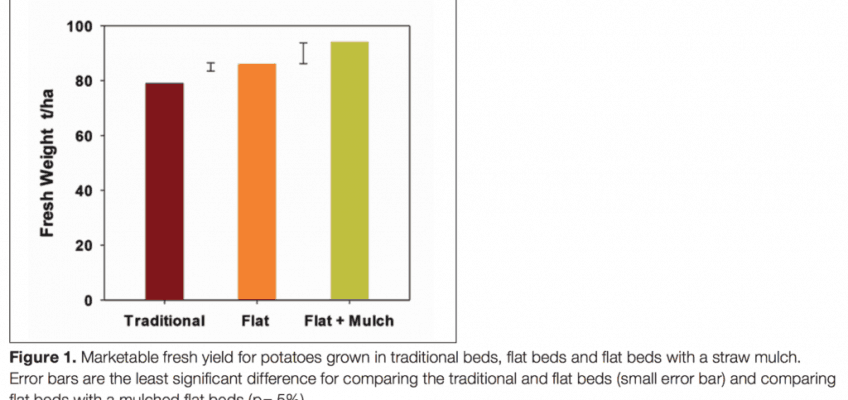Maximising the value of soil water – Findings from a potato bed trial…
Key points:
- Trials investigated water storage capacity of flat versus raised potato beds and the effects of mulching on potato crop yield.
- Soil cultivation and bed architecture influenced the proportion of plant available water storage.
- Mulches were beneficial in increasing yields, reducing evaporation and may improve the filling of storage pores.
- Soil water properties were dynamic in the cultivated zone and changed significantly over a growing season as soil consolidated. This has implications for determining irrigation requirements (amounts and rates) over the season.
- Quantifying the amount of soil water storage is important to precisely manage irrigation and maximise production.
Potatoes are easily water stressed and can quickly lose production as a consequence. Potato rooting systems are relatively small compared to other crops, limiting their ability to extract water from deeper soil layers. Hence, irrigation has become a requisite for attaining potential yields. Scheduling irrigation for shallow root crops is also relatively challenging because these crops deplete the small available soil water store quickly. Complicating this, irrigation application rates are often greater than the capability of the soil to absorb water, resulting in runoff or excess drainage through the largest soil pores into deeper soil layers. When this occurs, the smaller storage pores are bypassed, resulting in incomplete wetting of the soil, i.e. a proportion of the irrigation water applied is ineffective for crop production.
So to maximise production, increase water use efficiency and minimise water and nutrient losses, we need to improve our understanding of how water behaves in soil. This is one of the focuses of the Ministry of Business, Innovation and Employment (MBIE) research programme Maximising the Value of Irrigation led by Landcare Research, Plant & Food Research and FAR.
In a potato (‘Bondi’) field trial at Lincoln planted October 2015 we investigated the following questions:
- Do flat beds have better water storage than traditional ridged beds?
- Does mulching the surface (in our case with wheat straw) affect the total yield by reducing evaporation?
- How easily does the soil wet up?
- Do the hydrological properties change over time?
Results indicate that the at beds were better at storing and supplying water compared to the traditional beds. Furthermore, yields were greatest from plots that were mulched to reduce evaporation losses.
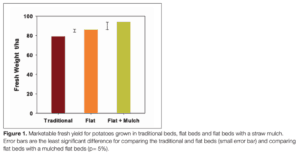 In addition to reducing evaporation losses from wet soil surfaces, mulching was likely to have had the added benefit of reducing ow through the large soil pores (macropores) by retarding the rate at which water in filtrated the soil.
In addition to reducing evaporation losses from wet soil surfaces, mulching was likely to have had the added benefit of reducing ow through the large soil pores (macropores) by retarding the rate at which water in filtrated the soil.
Overall, the mulch maintained much higher water content than the topsoil of the non-mulched plots (Figure 2 below), in particular during early crop growth when the canopy was developing. This higher water content appears to explain the increased yield.
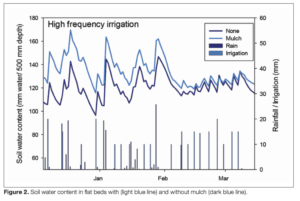
Soil water storage and drainage properties differed between the two types of beds. Results suggest that soil in the at beds was able to store 7% more water available for plant growth than the traditional beds (Figure 3).
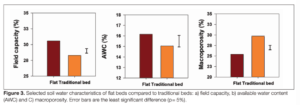
This is likely to have contributed to the higher yields from the at beds. Greater macroporosity in the traditional beds indicates that they will drain more rapidly. Greater consolidation of the
at beds (data not shown) may also improve root-soil contact, improving water and nutrient uptake.
Soil water storage and infiltration rates reduced over time.
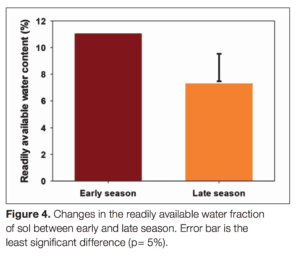 We measured soil water properties early in the trial when the potatoes were establishing and prior to harvest. Some key soil water-holding properties were affected. For example, the readily available water fraction declined by one-third in both types of beds. These results suggest that more frequent and lower volume applications of irrigation could be more ef cient as the season progresses.
We measured soil water properties early in the trial when the potatoes were establishing and prior to harvest. Some key soil water-holding properties were affected. For example, the readily available water fraction declined by one-third in both types of beds. These results suggest that more frequent and lower volume applications of irrigation could be more ef cient as the season progresses.
Next steps
This research will continue next season with an on-farm field trial designed to investigate options for increasing water and nutrient use efficiency by modifying bed architecture. This will be complimented by research to maintain and increase soil water availability for different irrigation management regimes.



